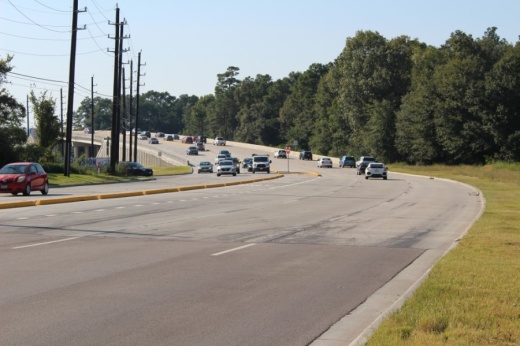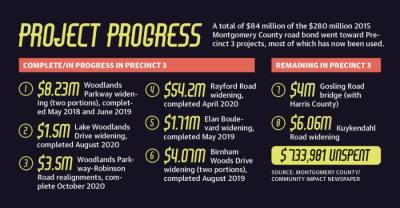A drop in statewide revenue in the next biennium as a result of the COVID-19 pandemic could affect funds for transportation projects statewide, and local government and mobility advocacy groups said they are planning ahead to keep up with the persisting transportation needs in Montgomery County.
The status of future projects, including those receiving state or federal funding through the Texas Department of Transportation or Houston-Galveston Area Council—a regional government planning cooperative—depends on the fiscal effects of the pandemic on government budgets. Officials and transportation planners are now looking ahead to the uncertainty of lowered funding over the coming years as Texas is projected to see a $4.58 billion budget shortfall in 2021 alone.
“We want to make sure we have all the options, all of the tools in the toolkit that we possibly can to assist the Legislature and to assist the state in terms of continuing to grow our transportation and infrastructure,” said Aaron Cox, the vice president of the Texas Association of Business.
Locally, Montgomery County is working through remaining projects funded by its $280 million road bond approved by voters in November 2015 along with new mobility and thoroughfare plans. However, the prospects of future roadway development remain unclear.
“We are pretty fortunate that we’ve got some projects that are already funded. ... I just don’t know how much [TxDOT will] be able to award new projects and new funding at this time,” Precinct 2 Commissioner Charlie Riley said. “We may miss a year or a year and a half with TxDOT trying to figure out how they can fund projects, but I don’t think it’s going to take too long to recover.”
The county thoroughfare plan was originally slated to be completed by end of this year, but progress has been delayed due to COVID-19, officials said.
But at the Oct. 13 Commissioners Court meeting, a representative from Brown & Gay Engineers, the company conducting the plan, delivered a brief update on the status of the plan in which they projected summer 2021 as the completion date.
“We are going to go ahead and get started now that we have formally kicked off the project to y’all,” said Megan Siercks, senior project manager at BGE. “Your county is growing. ... Things are changing, things are evolving, and with that, this plan needs to evolve.”
BGE will begin collecting data and holding stakeholder meetings, Siercks said. Siercks said county participation is crucial, and she asked each commissioner to create a stakeholder group of 10-15 individuals as well as to propose times for potential meetings.
County planning
Nearly five years after the passage of Montgomery County’s 2015 road bond, the majority of its dozens of planned projects are built or moving toward completion. Precincts 2 and 4 are also developing their own mobility plans to chart their needs, and a countywide thoroughfare plan update covering main arteries and rights of way is in progress, Riley said.
In Precinct 3, which was allocated $84 million through the bond, eight road projects funded by the bond are now built, including the $55 million widening of Rayford Road from east of I-45 to the Grand Parkway—the bond’s largest local item—which was completed under budget this spring, according to the precinct. Agencies such as TxDOT and the H-GAC are also examining remaining needs along some of the county’s most traveled roads to keep pace with a population that rose 33% between 2010 and 2019 to more than 607,000, according to the U.S. Census Bureau, and is projected to surpass 1 million by 2040, according to the H-GAC.
H-GAC Transportation Planner Carlene Mullins said improving the county’s east-west and north-south mobility by the mid-2020s is key to addressing its transportation needs amid ongoing growth. The focus is shared by county commissioners, according to Riley.
“The roads that are here from east to west, like [Hwy.] 105, [FM] 1097, [FM] 1488, [Hwy.] 242, are at capacity or near capacity or overcapacity, and those are the ones that we’re going to have to look at to try to expand before we try to put something new on the ground right now,” he said.
Projects around The Woodlands identified by the H-GAC in its 2021-24 Transportation Improvement Program—a regional plan prioritizing road projects to receive state and federal funding—include an estimated $24.6 million widening of Hwy. 242 west of I-45 and a $121.48 million extension of Old Conroe Road north across the West Fork San Jacinto River. Riley said his precinct has also been working with Conroe officials on that extension project. It would provide the county with an essential new north-south alternative to I-45, according to Mullins.
TxDOT spokesperson Emily Black said the agency is evaluating local needs with officials and residents, with a recent focus on east-west corridors such as FM 1488 and Hwy. 242. TxDOT’s access management study of FM 1488 from Magnolia to I-45 concluded this spring, resulting in the recommendation of more than $19 million in enhancements to one of the county’s major lateral arteries within the next five years.
The agency’s I-45 planning and environmental linkage study, spanning from north Houston to Conroe, is expected to bring proposed improvements for the county’s central corridor by late 2021.
Funding forecast
While the Old Conroe Road extension is slated to be financed by both local and federal sources, state funds will support projects along I-45, FM 1488 and other corridors in the area. Taxes in Texas are a primary source for transportation funds, and uncertainty surrounding the pandemic’s effects on the next several years of state finances and budgeting could affect the status of infrastructure improvements.
According to information from the office of Texas Comptroller Glenn Hegar, most categories of state tax collections decreased this spring and summer—including motor fuel and sales taxes that feed into the State Highway Fund, TxDOT’s primary funding source.
From April through August, monthly statewide sales and use tax collections dropped by an average of 6.05% over their 2019 values; vehicle sales taxes fell by an average of 19.68%; fuel taxes fell by an average of 16.02%; oil production taxes dipped by an average of 55.21%; and natural gas production taxes dipped by an average of 78.73%.
In total, the State Highway Fund is projected to see its state and federal income drop 17.13% from $14.3 billion in 2020 to $11.87 billion in 2021.
TxDOT said it is considering the long-range effects of the pandemic and projected revenue drops on its operations along with other state officials.
“At this time, TxDOT is closely monitoring revenue information shared by our state comptroller, anticipating various budget scenarios of the 87th [2021] Texas Legislature, and working closely with the Texas Congressional delegation on possible federal funding impacts. With any revenue impact, TxDOT will fully assess future plans and adjust accordingly,” said Veronica Beyer, the department’s director of media relations, in an email.
H-GAC Transportation Manager Allie Isbell said the agency is not expecting any immediate changes to its state or federal funding streams over the next several years given the group’s longer-term program timelines. However, she said new projects with state funding could be affected in the future.
“We can expect to see those impacts in the next two to three years. How significant they will be, I don’t think anyone quite has a handle on that yet, but there will be a dent because of the revenue forces that fund those projects,” Isbell said.
Progress amid pandemic
Although some financial effects of the pandemic on statewide transportation initiatives may not be known until the Texas Legislature’s spring session or later, many road projects in Montgomery County and throughout the state remain on schedule or have developed along a faster timeline this spring and summer.
Officials said projects coordinated through TxDOT and the H-GAC have moved quickly and therefore often incurred lower costs due to lower traffic volumes through much of this year.“Keeping the projects moving saved time, got projects completed sooner, helped limit the disruption of construction and even saved taxpayers money by avoiding additional costs that project stoppage or delays could have created,” Beyer said.
Around The Woodlands, two additional bond projects—the $1.5 million widening of Lake Woodlands Drive west of I-45 and the $3.5 million reconfiguration of the Woodlands Parkway-Robinson Road interchange and Patsy Lane intersection—were substantially completed this summer following the Rayford project’s completion in the spring.
Still, Precinct 3 has listed more than $112 million worth of unfunded projects in planning phases even as bond funding is used up. Those projects and others in the county could be tackled through precinct funding or a possible future county road bond—a package that may no longer be feasible in the short term. Precinct 3 Commissioner James Noack could not be reached for comment before press time.
“We ... had in the back of our mind that once we get these road projects done and we’ve proven to the folks that we did what we told them we were going to do, that we were possibly going to ask to go out for another bond,” Riley said. “The situation now that we’re in with COVID[-19] and the shutdowns ... this is just not the time to even be thinking about going out for another road bond.”Montgomery County Judge Mark Keough said in February that discussion of a new bond could take place in late 2020 or early 2021, although he also said state and federal dollars would also be needed to address the county’s growth-related mobility needs.
Andrea French, the executive director of the Transportation Advocacy Group-Houston, also noted the positive effects the pandemic may have on the timeline of local road projects. And in addition to evaluating the revenues lost due to COVID-19, French said TAG and other experts are considering ways to boost funding—such as fees for alternatively fueled vehicles or an inflation-adjusted gas tax—to support future projects.
“We understand there are other priorities this session, but our argument is one of the things we need to work on is jobs and bolstering our economy, and a great way to do that is to invest in transportation,” French said.
Shawn Arrajj, Andrew Christman, Anna Lotz and Eva Vigh contributed
to this report.







